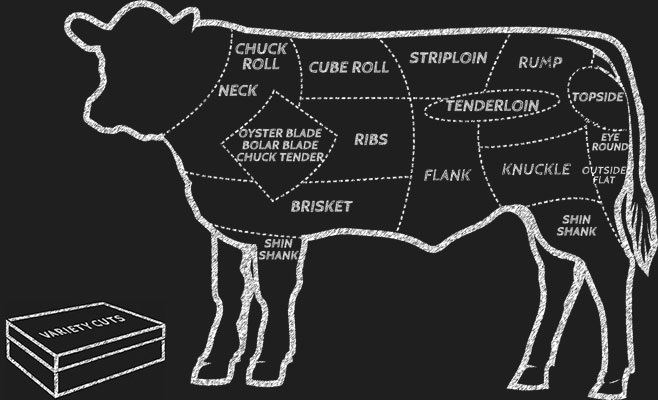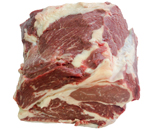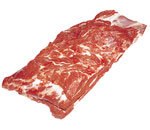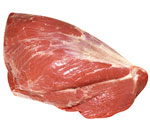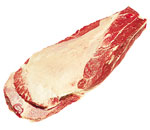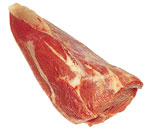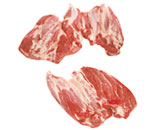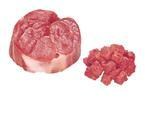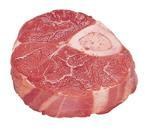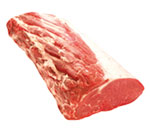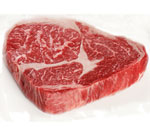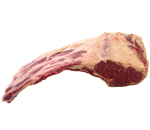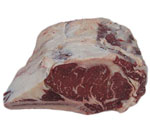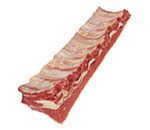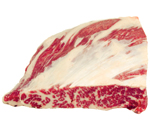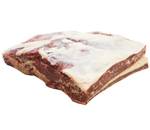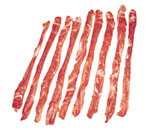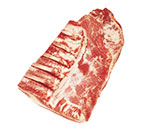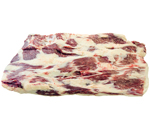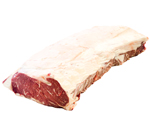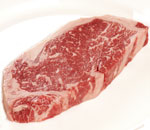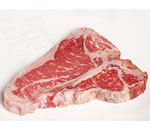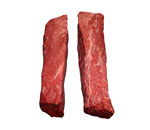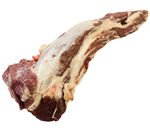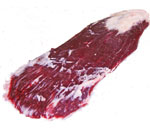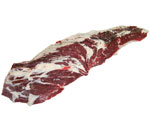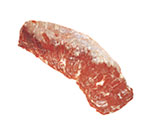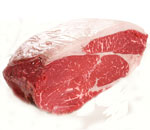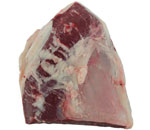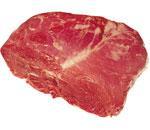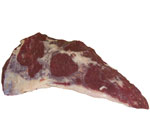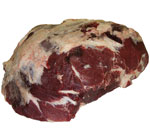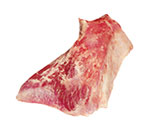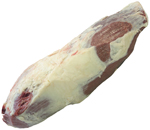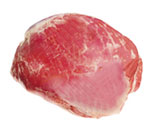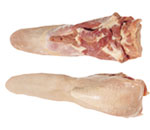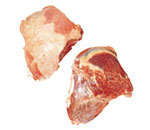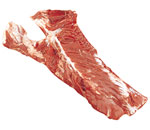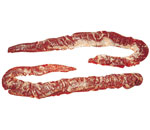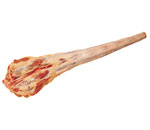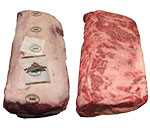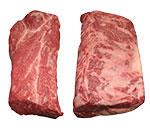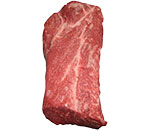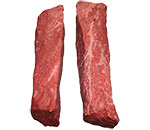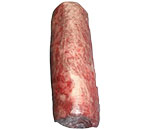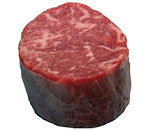|
Chuck Roll/ Train de Cotes
Prepared from the forequarter after the brisket and rib set are removed.
Neck Meat/ Collier sans os
Prepared from the neck region, the neck is separated from the chuck to give neck meat.
Bolar Blade/ Paleron/ Shoulder Clod
Prepared from the shoulder blade. The Bolar blade is a large piece of meat that is identified from the clod (or blade) by separating the oyster blade and bolar blade.
Blade steakBlade steak comes from the shoulder blade. It is a versatile cut that can be barbecued and pan-fried, cut into strips and stir-fried or diced for slow cooking in a braise. Oyster Blade/ Dessus de palette/ Top Blade
Prepared from the forequarter after the brisket and rib set are removed. The oyster blade is connected to the shoulder blade of the beef and is identified by removing the muscle from the clod (or blade) at the scapula.
Oyster blade steakThe oyster blade sits on the shoulder blade and when separated from the shoulder can be cut into steaks for pan-frying or barbecuing. It has a thin line of gristle that runs through the centre of the steak which should be scored to prevent curling when cooking. It is also a perfect cut for stir-frying with its full flavour and tenderness. Chuck Tender/ Filet d'Epaule/ Mock Tender
Chuck Tender is a conical shape muscle lying lateral to the blade bone on the cranial side of the blade ridge and is removed from the Forequarter following the natural seam.
Shin/ Shank
Prepared from either forequarter or hindquarter legs after the leg is removed. Gravy beef
Gravy beef can come from the shin area of the leg or the heel muscle in the silverside. As this cut comes from a muscle used constantly for movement, it contains a high amount of connective tissue. This connective tissue breaks down when prepared using slow moist cooking methods such as casseroling and braising imparting a rich, full bodied flavour and a delicious gelatinous texture. Shin bone-in
Shin bone-in is prepared from the bottom portion of either the front or rear leg. As this cut comes from a muscle used constantly for movement, it contains a high amount of connective tissue. This tissue breaks down when prepared using slow moist cooking methods such as casseroling and braising imparting a rich, full bodied flavour and a delicious gelatinous texture. Cube Roll/ Entrecote/ Rib Eye Roll
Prepared from the forequarter. The brisket and chuck is removed at the rib set.
Cube Roll Steak
Cube Roll steak is prepared from a boneless beef rib set. The cube roll steak is found on the back of the animal and runs from the striploin (sirloin) to the chuck. Being a 'support' muscle not subjected to the heavy work of moving the animal around cube roll steaks are tender, tasty and moist and perform best with fast hot cooking methods such as pan-frying and barbecuing or stir-frying when thinly sliced. Tomahawk
Prepared similarly to the ribs prepared by leaving the bone rib set on the cube roll. The bone length is cut to approximately 250mm from the eye muscle.
Ribs Prepared/ OP Rib
The ribs prepared is an impressive roast for entertaining and is simply the cube roll (scotch fillet) with the rib bones attached. The cube roll is found on the back of the animal and runs from the striploin (sirloin) to the blade (shoulder) area. A ribs prepared is best roasted in a hot oven and not cooked more than medium. Given its tender nature it can also be sliced into steaks to barbecue and pan-fry or strips to stir-fry.
Bone-in Short Rib
Prepared from the forequarter after removal of the brisket/ ribs prepared and chuck.
Short Rib Meat
Short rib meat is the thickest the muscle covering the 5th to the 8th rib following the dorsal cutting line of the brisket. The muscle has the rib bones and chuck rib meat removed.
Chuck Rib Meat/ Plat 5 cotes/ short ribs (from chuck)
Chuck Rib meat is derived from a bone-in short rib when the muscle is covering the 3rd to 5th rib and cut into two and the bone is removed. The muscle will have significant marbling.
Intercostals/ Rib Fingers
The intercostal muscles run between the rib bones of the hindquarter and forequarter.
Point End Brisket/ Poitrine
Prepared from a 12 rib forequarter. The point end is from the cranial the brisket.
Navel End Brisket
Prepared from a 12 rib forequarter. The navel end brisket is from the belly end of the brisket.
Striploin/ Faux filet avec chainette
Prepared from the hindquarter between the cube roll and the rump.
Sirloin Steak
The striploin is located along the spine in the hindquarter and runs from the ribs to the rump, sitting above the tenderloin. Sirloin steaks are cut from the rump end of the striploin. The rib end of the striploin forms the large piece of beef on the T-bone steak. Located along the spine where the muscles do less work, sirloin steaks are tender and best suited to high temperature cooking such as pan-frying, barbecuing and stir-frying (when thinly sliced). Shortloin
Loin Fillet
Click here for further information about this Tenderloin/ Filet avec chainette
Prepared from the hindquarter and is removed in one piece within the lumbar vertebrae.
Flank steak/ Bavette Flanchet
Prepared from a Thin Flank. The Flank is located directly beneath the loin in the abdominal area.
Flap Meat
Prepared from an internal flank plate. The thin tapered ends of the muscle are trimmed.
Inside Skirt/ Bavette d/aloyau
A boneless portion of the flank trimmed free of fat and membranes.
Rump/ Culotte/ Top sirloin butt
Prepared from the hindquarter and is removed by a cut separating the rump from the butt and another separating the rump from the shortloin.
Rump cap/ Aiguillette baronne/ Top Sirloin Cap/ Pichana
Prepared from a rump by separating the rump cap away from the rostbiff. Rump cap is a cut of beef that is in some countries considered to be the best cut of beef due to its marked flavour. It is famous and well liked in South American countries, especially Brazil where it is known as "Picanha". Rump cap can be roasted whole in a hot oven, barbecued whole or cut (across the grain) into steaks or sliced into thin strips for a tender and delicious beef stir-fry.
Rostbiff
Prepared from a rump by separating the rump cap and rostbiff along the natural seam. Rostbiff is a cut of beef that is in some countries considered to be the best cut of beef due to its marked flavour. Rostbiff can be roasted whole in a hot oven, barbecued whole or cut (across the grain) into steaks or sliced into thin strips for a tender and delicious beef stir-fry.
Tritip/ Aiguillette rumsteak/ Bottom sirloin triangle
The tritip is a small triangular muscle taken from the bottom part of the full rump. It is a very tender and tasty cut that is very versatile.
Topside/ Coin Entier/ Top (inside) round
Topside comes from the inside of the hind leg, between the thick flank and the silverside.
Outside Flat/ Tranche Carree/ Bottom (outside) round
Outside Flat is prepared from an Outside (item 2030) by the removal of the Outside Flat along the natural seam between the Eye Round (M. semitendinosus) and the Outside Flat (M. gluteobiceps).
Eye Round/ Piece Ronde
The Eye Round is prepared from the Outside (item 2030) by following the natural seam between the Outside Flat (M. gluteobiceps) and the Eye Round (M. semitendinosus) separating the two muscles. Knuckle/ Jarret ou Gite Arriere/ Knuckle (sirloin tip)
Prepared from a hindquarter and removed along the natural seams between the silverside and topside in one piece.
VARIETY CUTSTongue
Tongue is an offal item removed from the head on day of slaughter.
Cheek meat
Removed from the cheek of the head on day of slaughter, cheek meat is an offal item.
Hanging tender/ Onglet/ Thick Skirt
Removed from the diaphragm cavity of the animal on day of slaughter, Hanging Tender is an offal item.
Outside skirt/ Hampe/ Thin Skirt
Removed from the diaphragm cavity of the animal on day of slaughter, Outside skirt is an offal item.
The outside skirt is ideal for yakiniku style cooking. Tail
Removed from the carcass on day of slaughter, tail is an offal item.
Stockyard loin fillet
Remove striploin from vacuum bag and trim the salvage fat and all sinew back to redmeat from the lateral surface of the striploin.
Remove the side-chain (M.mutifidi dorsi) and trim off all fat.
Remove the crow's foot (M. gluteus Medius) from the caudel end of the striploin and trim off all underlying fat. This will leave a one muscle (M. longissimus dorsi) fully denuded striploin.
Cut this piece in half length ways in to two equal portions. Complete a final trim removing any remaining fat, sinew and/ or loose pieces of meat.
Roll each piece tightly into a cylinder shaped roll using plastic wrap and let it set in a refrigerator for a minimum 4 hours.
The Loin-fillet rolls are now ready for portioning. Care must be taken to remove all plastic wrap before cooking. The fat can be minced and used to add flavour for mince, meatballs, hamburger patties or other value added products. The sinew and connective tissue can be rendered into stock. The side chain; crow's foot and other pieces of trim can be used as lean trim.
|
||||||||||||||||||

